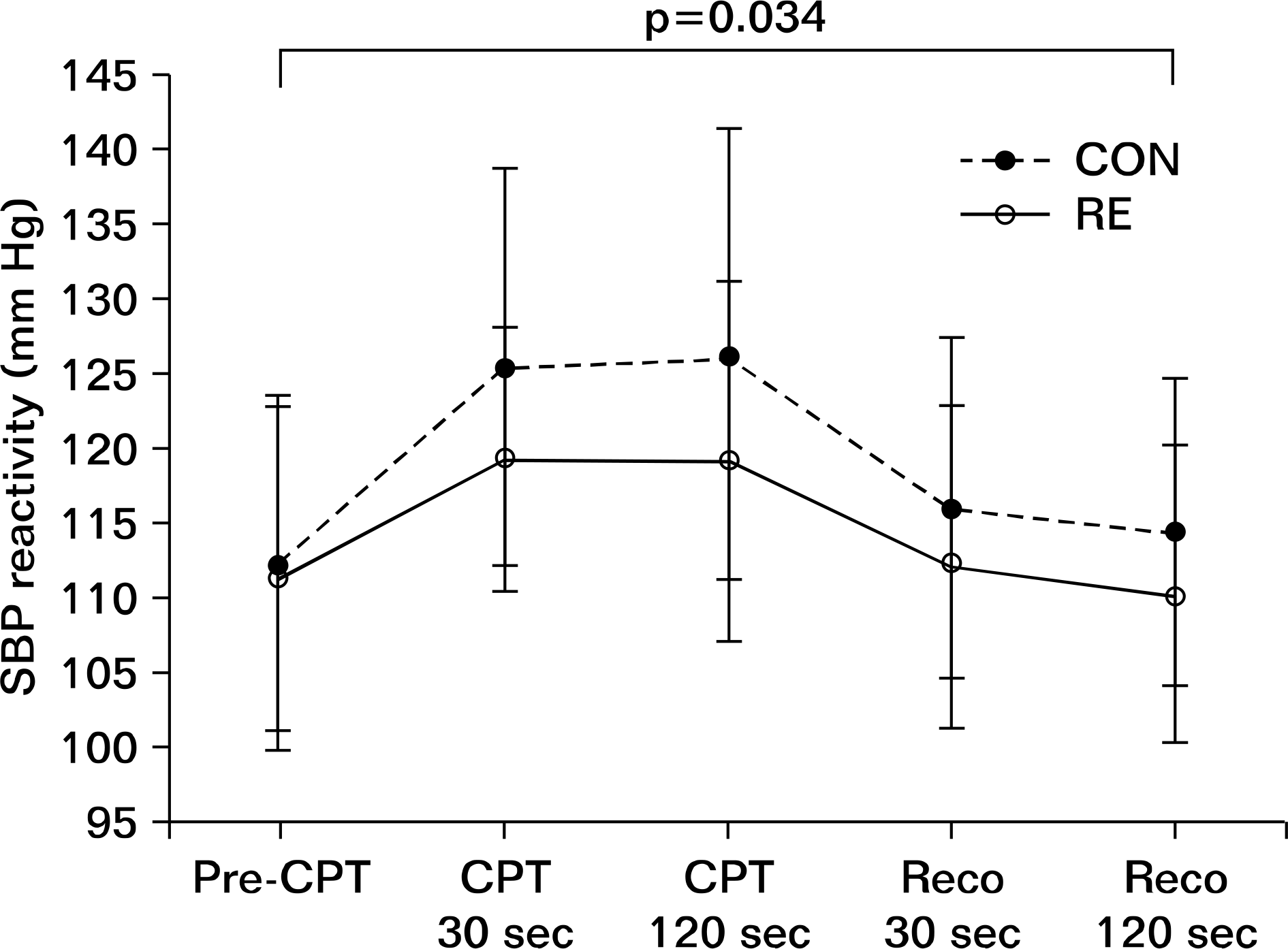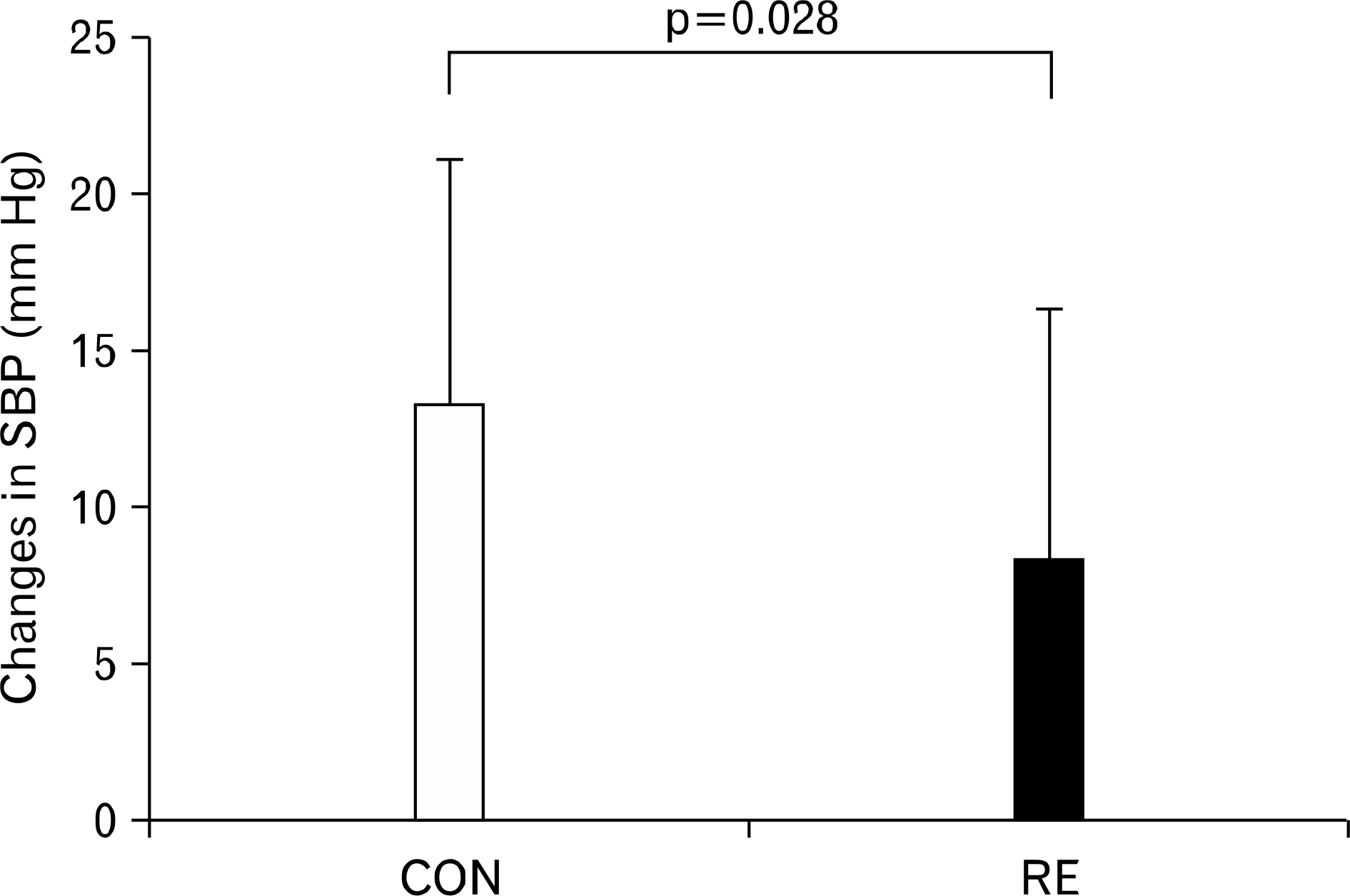Abstract
Increased cardiovascular reactivity to sympathetic challenge is associated with increased risk of hypertension and cardiovascular disease. Acute aerobic exercise blunts stress related cardiovascular reactivity, but whether acute resistance exercise attenuates cardiovascular reactivity is unknown. We tested the hypothesis that acute resistance exercise will attenuate hemodynamic reactivity to a cold pressor test in healthy adults. Using a randomized cross-over trial, 20 healthy adults (9 males, 11 females; age, 26±5 years; body mass index, 23.85±3.19 kg/m2) completed two testing sessions, separated by 1 week. Sessions consisted of either a control condition or an acute resistance exercise prior to cold pressor testing (two sets, eight exercises, 40%–60% of 1 repetition maximum for upper and lower extremity). Blood pressure and heart rate measured at baseline, 30 seconds, and 120 seconds during a 3-minute cold pressor test (ice water, 4oC), and 30 seconds and 120 seconds post-cold pressor testing, respectively. During the cold pressor test, there were significant increases in blood pressures and heart rate (p<0.05) in both groups. However, acute resistance exercise attenuated increases in systolic blood pressure, but not heart rate, compared with the control (all p<0.05 for interact effects). These findings show that the cold pressor test significantly increases blood pressures and heart rate in healthy adults, but an acute bout of resistance exercise attenuated the hemodynamic response to the cold pressor test. Therefore, resistance exercise may have a favorable effect on cardiovascular reactivity to sympathetic activation in healthy adults.
Go to : 
REFERENCES
1.Matthews KA., Katholi CR., McCreath H, et al. Blood pressure reactivity to psychological stress predicts hypertension in the CARDIA study. Circulation. 2004. 110:74–8.

2.Esler M. The sympathetic system and hypertension. Am J Hypertens. 2000. 13(6 Pt 2):99S–105S.
3.Manuck SB., Olsson G., Hjemdahl P., Rehnqvist N. Does cardiovascular reactivity to mental stress have prognostic value in postinfarction patients? A pilot study. Psychosom Med. 1992. 54:102–8.

4.Menkes MS., Matthews KA., Krantz DS, et al. Cardiovascular reactivity to the cold pressor test as a predictor of hypertension. Hypertension. 1989. 14:524–30.

5.Hines EA Jr., Brown GE. A standard stimulus for measuring vasomotor reactions: its application in the study of hypertension. Mayo Clin Proc. 1932. 7:332–35.
6.Flaa A., Eide IK., Kjeldsen SE., Rostrup M. Sympathoadrenal stress reactivity is a predictor of future blood pressure: an 18-year follow-up study. Hypertension. 2008. 52:336–41.
7.Kasagi F., Akahoshi M., Shimaoka K. Relation between cold pressor test and development of hypertension based on 28-year follow-up. Hypertension. 1995. 25:71–6.

8.Forcier K., Stroud LR., Papandonatos GD, et al. Links between physical fitness and cardiovascular reactivity and recovery to psychological stressors: a meta-analysis. Health Psychol. 2006. 25:723–39.

9.Dishman RK., Jackson EM., Nakamura Y. Influence of fitness and gender on blood pressure responses during active or passive stress. Psychophysiology. 2002. 39:568–76.

10.Spalding TW., Lyon LA., Steel DH., Hatfield BD. Aerobic exercise training and cardiovascular reactivity to psychological stress in sedentary young normotensive men and women. Psychophysiology. 2004. 41:552–62.

11.Brownley KA., Hinderliter AL., West SG., Girdler SS., Sherwood A., Light KC. Sympathoadrenergic mechanisms in reduced hemodynamic stress responses after exercise. Med Sci Sports Exerc. 2003. 35:978–86.

12.Hamer M., Taylor A., Steptoe A. The effect of acute aerobic exercise on stress related blood pressure responses: a systematic review and meta-analysis. Biol Psychol. 2006. 71:183–90.

13.Halliwill JR. Mechanisms and clinical implications of postexercise hypotension in humans. Exerc Sport Sci Rev. 2001. 29:65–70.

14.DeVan AE., Anton MM., Cook JN., Neidre DB., Cortez-Cooper MY., Tanaka H. Acute effects of resistance exercise on arterial compliance. J Appl Physiol (1985). 2005. 98:2287–91.

15.Heffernan KS., Fahs CA., Iwamoto GA, et al. Resistance exercise training reduces central blood pressure and improves microvascular function in African American and white men. Atherosclerosis. 2009. 207:220–6.

16.Jakovljevic DG., Hallsworth K., Zalewski P, et al. Resistance exercise improves autonomic regulation at rest and haemo-dynamic response to exercise in non-alcoholic fatty liver disease. Clin Sci (Lond). 2013. 125:143–9.

17.Haskell WL., Lee IM., Pate RR, et al. Physical activity and public health: updated recommendation for adults from the American College of Sports Medicine and the American Heart Association. Circulation. 2007. 116:1081–93.
18.Casey DP., Braith RW., Pierce GL. Changes in central artery blood pressure and wave reflection during a cold pressor test in young adults. Eur J Appl Physiol. 2008. 103:539–43.

19.Baechle TR., Earle RW. National Strength and Conditioning Association. Essentials of strength training and conditioning. 2nd ed.Champaign: Human Kinetics;2000.
20.Moreira SR., Lima RM., Silva KE., Simoes HG. Combined exercise circuit session acutely attenuates stress-induced blood pressure reactivity in healthy adults. Braz J Phys Ther. 2014. 18:38–46.

21.Pickering TG., Gerin W. Cardiovascular reactivity in the laboratory and the role of behavioral factors in hypertension: a critical review. Ann Behav Med. 1990. 12:3–16.

22.West SG., Brownley KA., Light KC. Postexercise vasodilatation reduces diastolic blood pressure responses to stress. Ann Behav Med. 1998. 20:77–83.

23.Lentini AC., McKelvie RS., McCartney N., Tomlinson CW., MacDougall JD. Left ventricular response in healthy young men during heavy-intensity weight-lifting exercise. J Appl Physiol (1985). 1993. 75:2703–10.

24.Meyer K., Hajric R., Westbrook S, et al. Hemodynamic responses during leg press exercise in patients with chronic congestive heart failure. Am J Cardiol. 1999. 83:1537–43.

25.Melo CM., Alencar Filho AC., Tinucci T., Mion D Jr., Forjaz CL. Postexercise hypotension induced by low-intensity resistance exercise in hypertensive women receiving captopril. Blood Press Monit. 2006. 11:183–9.

26.McCubbin JA., Surwit RS., Williams RB Jr. Endogenous opiate peptides, stress reactivity, and risk for hypertension. Hypertension. 1985. 7:808–11.

27.Williamson JW., McColl R., Mathews D. Changes in regional cerebral blood flow distribution during postexercise hypotension in humans. J Appl Physiol (1985). 2004. 96:719–24.

28.Biddle SJ. Emotion, mood and physical activity. Biddle SJ, Fox KR, Boutcher SH, editors. editors.Physical activity and psychological well-being. 1st ed.London: Routledge;2000. p. 63–87.
Go to : 
 | Fig. 1.Change in systolic blood pressure reactivity in response to cold pressor test following resistance exercise or control trial. p-value for time×trial interactive effect. CON: control trial, RE: resistance exercise trial, SBP: systolic blood pressure, CPT: cold pressor test. |
 | Fig. 2.Comparison of mean changes in systolic blood pressure at 120 seconds during cold pressor test between resistance and control trial. CON: control trial, RE: resistance exercise trial, SBP: systolic blood pressure. |
Table 1.
Physical characteristics of the subjects
Table 2.
Exercise intensity
Table 3.
Cardiovascular reactivity in response to cold pressor test at each time period in following resistance exercise or control trials
| Variable | Pre-CPT | CPT 30 sec | CPT 120 sec | Recovery 30 sec | Recovery 120 sec | p-value |
|---|---|---|---|---|---|---|
| SBP (mm Hg) | ||||||
| RE | 111.15±11.39 | 119.40±8.85 | 119.35±11.94 | 112.15±10.58 | 110.95±9.84 | 0.001∗ |
| CON | 112.00±11.23 | 125.00±13.28 | 126.00±14.91 | 115.75±11.40 | 114.20±10.30 | 0.250† |
| 0.034‡ | ||||||
| DBP (mm Hg) | ||||||
| RE | 66.10±7.64 | 74.95±7.99 | 73.65±9.39 | 66.80±6.71 | 66.80±6.71 | 0.015∗ |
| CON | 67.90±5.14 | 80.55±9.28 | 79.20±8.39 | 70.20±6.69 | 70.65±6.01 | 0.047† |
| 0.319‡ | ||||||
| PP (mm Hg) | ||||||
| RE | 45.85±8.42 | 45.30±7.71 | 46.60±11.06 | 46.55±9.84 | 44.95±7.44 | 0.015∗ |
| CON | 43.95±8.32 | 44.70±10.35 | 46.50±11.41 | 46.15±11.14 | 41.85±10.12 | 0.664† |
| 0.544‡ | ||||||
| HR (bpm) | ||||||
| RE | 68.25±11.24 | 72.50±13.25 | 69.95±11.61 | 67.85±10.09 | 66.35±9.93 | 0.001∗ |
| CON | 58.80±9.37 | 64.85±11.05 | 61.35±10.04 | 59.95±9.14 | 58.85±9.91 | 0.013† |
| 0.819‡ | ||||||
| RPP | ||||||
| RE | 7,570.00±1,498.91 | 8,644.00±1,678.18 | 8,318.40±1,495.92 | 7,556.90±1,196.10 | 7,330.25±1,148.34 | 4 0.001∗ |
| CON | 6,571.70±1,169.20 | 8,078.50±1,466.74 | 7,717.35±1,493.79 | 6,920.75±1,142.03 | 6,704.10±1,194.89 | 9 0.085† |
| 0.208‡ |




 PDF
PDF ePub
ePub Citation
Citation Print
Print


 XML Download
XML Download